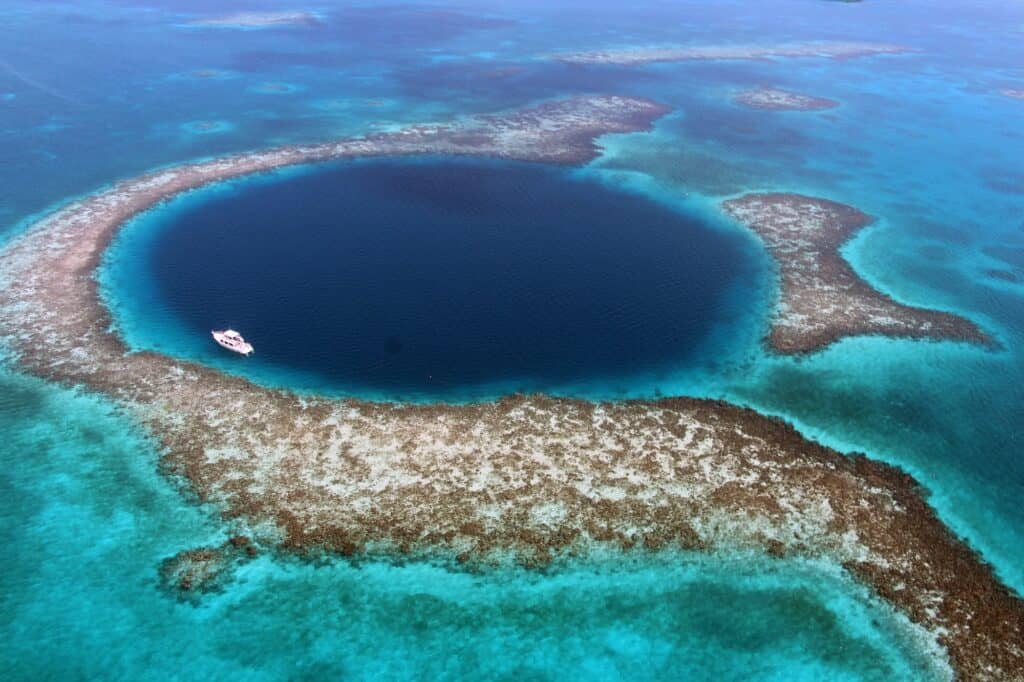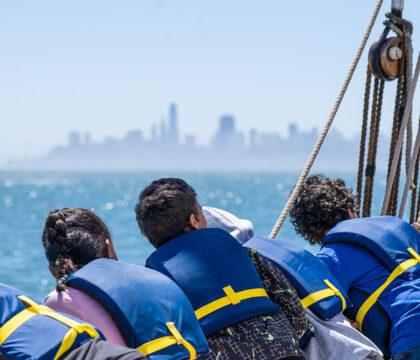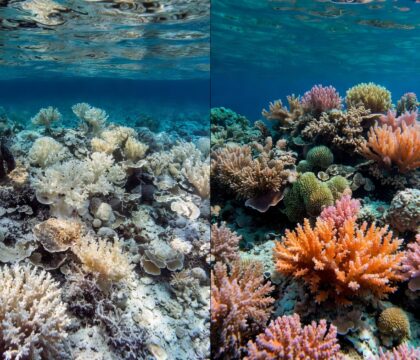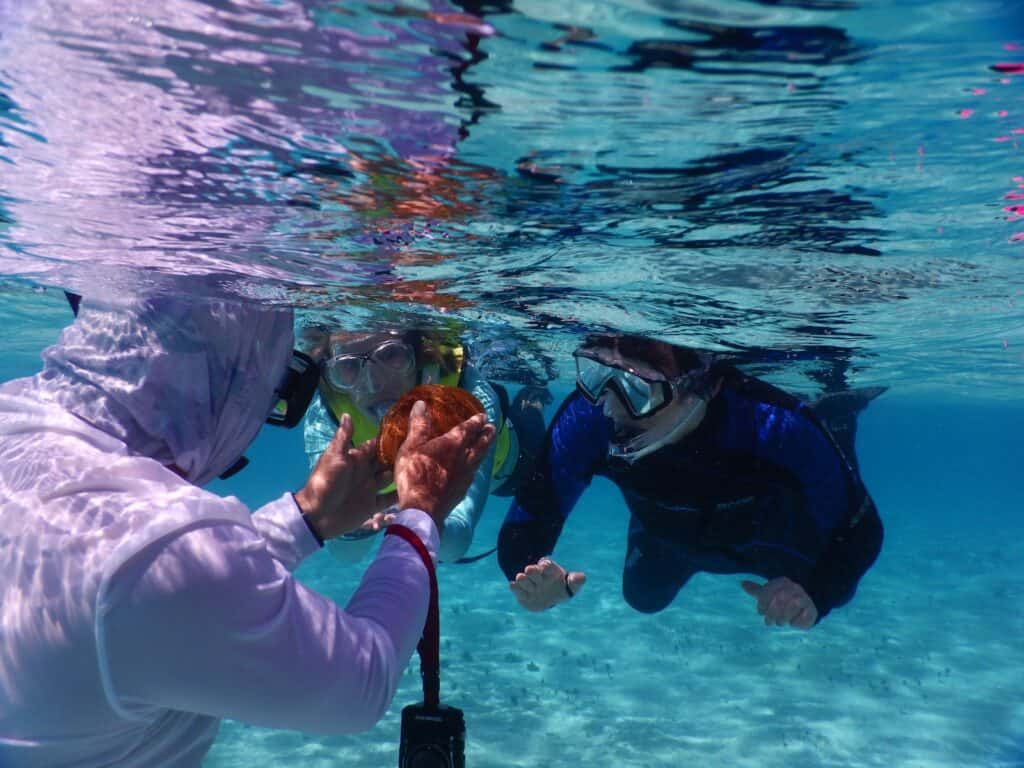May 29, 2025 • Travel Ideas
If the sky is clear, as it often is in Belize, the first thing you will see is an arc of turquoise shining through the surface of the ocean. This is the ridge of the Great Blue Hole, the largest marine sinkhole in the world. It is the ancient remnant of a massive limestone cave that collapsed at the end of the last Ice Age. Today, the shallow ridge is covered in coral and teeming with wildlife from the surrounding Mesoamerican Reef. Meanwhile, the bottom of the Great Blue Hole holds clear remnants of its geological past: ancient stalagmites rising like teeth from the ocean floor.

Belize’s Great Blue Hole stretches nearly a thousand feet across and is a near-perfect circle. The ridge is shallow and covered in a vibrant coral reef.
The stunning visuals, remarkable underwater formations, and dazzling wildlife have made the Great Blue Hole a bucket-list destination for ocean lovers, naturalists, and photographers. Jacques Cousteau helped make the Great Blue Hole famous in the 1970s, and its size still stuns visitors today: nearly 1,000 feet wide and more than 400 feet deep. Yet what many travelers do not realize is that nearby lies Half Moon Caye, a pristine island sanctuary, which offers a complementary experience that includes white sand beaches, excellent snorkeling, and unique birdlife. Together, these two destinations form part of a UNESCO World Heritage Site.
Half Moon Caye is a true Caribbean gem. Loggerhead, hawksbill, and green sea turtles nest along the shore. Iconic birds, like Red-footed Boobies and Magnificent Frigatebirds (which can expand their throats like the gullet of a toad) nest by the thousands. And in the turquoise waters just offshore, coral reefs host schools of tropical fish. An ideal trip to Half Moon Caye might include a canopy walk, relaxation on the beach, and ample time snorkeling.
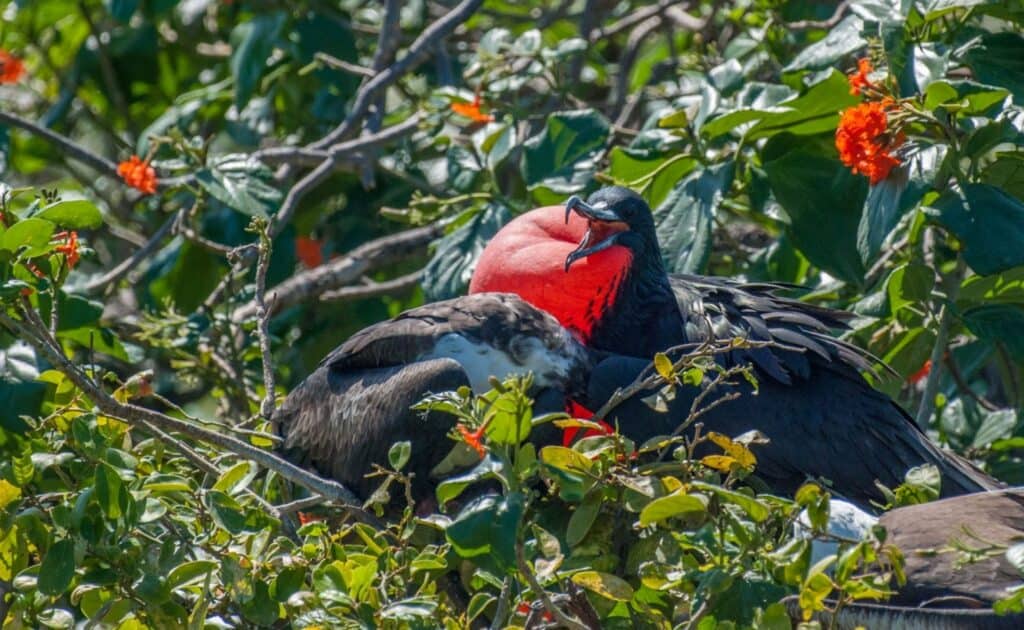
Half Moon Caye, which lies near the Great Blue Hole, is a birders’ paradise and home to iconic Frigatebirds. © Joy Marzolf
So, what should you know before planning a trip to the Great Blue Hole? Oceanic Society has been guiding tours to the Great Blue Hole and Half Moon Caye for nearly 40 years, and below we’ve compiled answers to some common questions.
Common Questions about the Great Blue Hole
Where is the Great Blue Hole? The Great Blue Hole lies roughly 40 miles offshore from mainland Belize, in the Caribbean Sea. Located within Lighthouse Reef Atoll, it is part of the Mesoamerican Reef, the second-largest reef system in the world. While exploring the area, travelers will be surrounded by coral reefs and the vast open ocean, providing a wilderness experience more akin to the South Pacific than the well-worn tourist paths of the Caribbean.
How do I get to the Great Blue Hole? While day trips from Belize City are possible, they involve long and sometimes bumpy boat rides (2-3 hours each way). Oceanic Society’s Belize snorkeling tours stay at Turneffe Atoll, a beautiful coral-formed island just 10 miles from the Great Blue Hole, making it the perfect base of operations for exploring the surrounding mangrove-clad islands, coral reefs, and meadows of seagrass.
When is the best time of year to visit the Great Blue Hole and Half Moon Caye? The dry season, from November through May, offers the best conditions: calmer seas, clearer skies, and better water visibility. Avoid hurricane season, which generally runs from June through October.
Do I need to be a diver to experience the Great Blue Hole? No. While diving the Great Blue Hole is a bucket-list destination for many divers, the surrounding ridge and shallow reefs of Lighthouse Reef and Half Moon Caye are perfect for snorkeling.
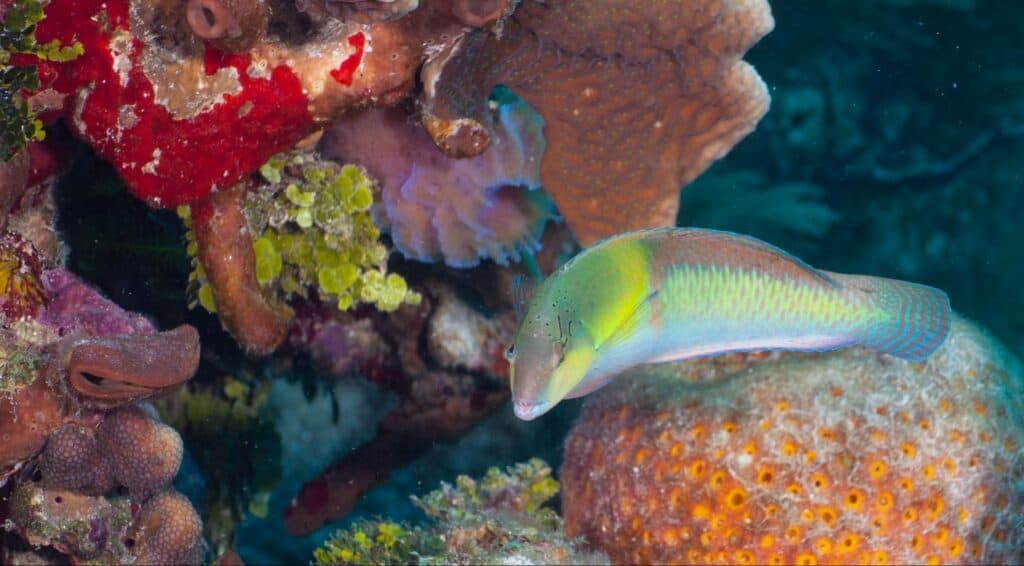
The coral reefs of the Great Blue Hole, Half Moon Caye, and other snorkeling sites in the Belize Barrier Reef are some of the healthiest in the Caribbean. © Joy Marzolf
What should I pack on a trip to the Great Blue Hole? In addition to the basics like ample sun protection (a long-sleeve rashguard or wetsuit is always better than sunscreen, which can damage reefs), make sure to pack your own snorkeling gear that fits properly. There is nothing worse than a leaky snorkel mask when you are on a trip of a lifetime, so it’s best to come prepared!
What is the mystery of the Great Blue Hole? No, the Great Blue Hole isn’t the home of sea monsters. No, it isn’t a bottomless pit. When a team of scientists in a submarine searched the bottom (which is nearly 400 feet deep) they didn’t find any otherworldly mysteries, but more signs of its geological past (including stalagmites stretching nearly 40 feet tall), the bodies of two long-lost scuba divers, and even a “conch graveyard” for the unlucky ones that tumbled down.
Does anything live in the Great Blue Hole? Yes, but more life can be found around it than within its depths. The Great Blue Hole lies within Lighthouse Reef in the heart of the Mesoamerican Barrier Reef – the second largest reef system in the world and one of the most biodiverse with more than 500 species of fish and over 65 species of hard coral. Due to its proximity to the open ocean, large marine animals can also be found nearby , including reef sharks, sea turtles, groupers, and rays.
How long is a trip to the Great Blue Hole? Most trips to the Great Blue Hole include a visit to nearby Half Moon Caye and span a full day, departing after breakfast and returning at dusk. Staying at nearby Turneffe Atoll allows more time at each destination and reduces transit time significantly.
Experience the Great Blue Hole with Oceanic Society
Our expert-led Belize snorkeling trips include a full day exploring the Great Blue Hole and Half Moon Caye. Our guests stay nearby in Turneffe Atoll, away from the crowds, and surrounded by rich marine ecosystems that make it a hotspot for Belize wildlife.
Not only a trip of a lifetime, each booking with Oceanic Society supports vital marine conservation efforts, including the removal of 200 pounds of plastic from ocean, and the work of our grassroots partners at Turneffe Atoll Trust and the TASA Marine Reserve Station to preserve Belize’s ocean wildlife and habitats for generations to come.

